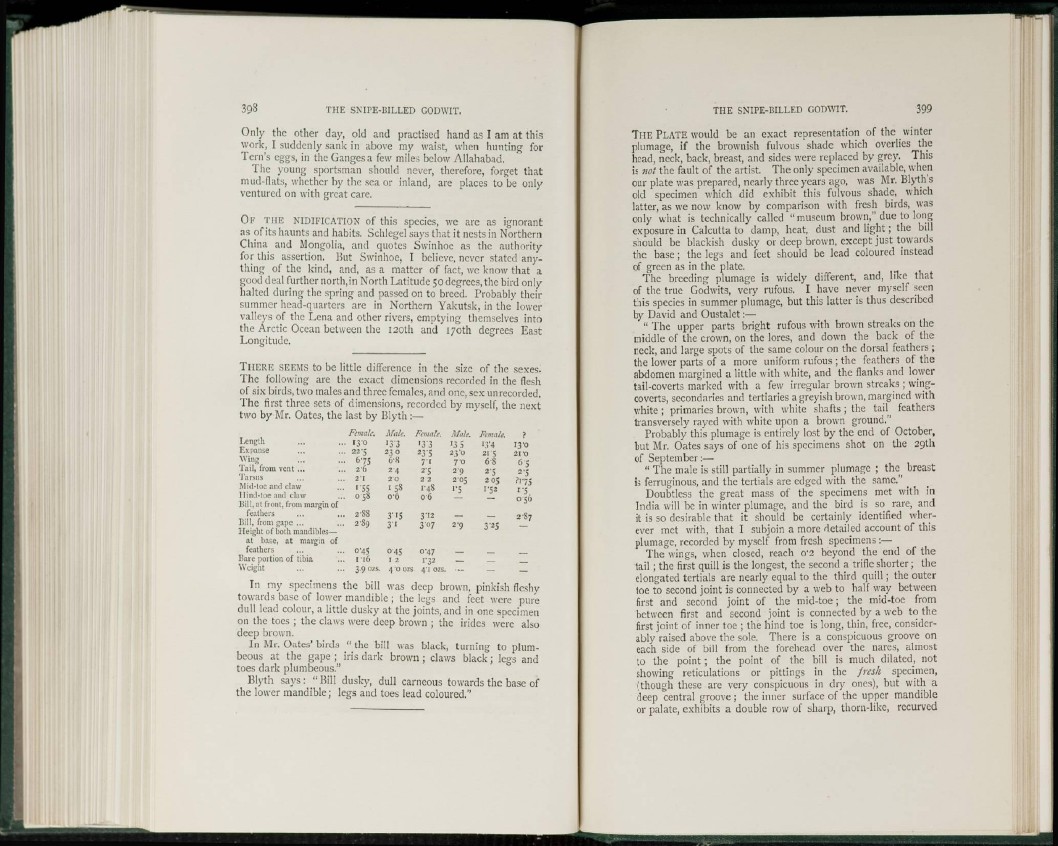
Only the other day, old and practised hand as I am at this
work, I suddenly sank in above my waist, when hunting for
Tern's eggs, in the Ganges a few miles below Allahabad.
The young sportsman should never, therefore, forget that
mud-flats, whether by the sea or inland, are places to be only
ventured on with great care.
OF THE NIDIFICATION of this species, we are as ignorant
as of its haunts and habits. Schlegel says that it nests in Northern
China and Mongolia, and quotes Swinhoe as the authority
for this assertion. Hut Swinhoe, I believe, never stated anything
of the kind, and, as a matter of fact, we know that a
good deal further north,in North Latitude 50 degrees, the bird only
halted during the spring and passed on to breed. Probably their
summer head-quarters are in Northern Yakutsk, in the lower
valleys of the Lena and other rivers, emptying themselves into
the Arctic Ocean between the 120th and 170th degrees East
Longitude.
THERE SEEMS to be little difference in the size of the sexes.
The following are the exact dimensions recorded in the flesh
of six birds, two males and three females, and one, sex unrecorded.
The first three sets of dimensions, recorded by myself, the next
two by Mr. Oates, the last by Blyth :—
?
13-0
21-0
Length
Expanse
Female. Male. Female. Male. Female.
'33 •33 13 5 I3'4
22-5 230 235 23'° 2I'5
n 68
Wing ... ... 675 6-8 71 70 6 8 6'!
1 ail, from vent
26 24 25 29 2-5
a'i 20 2 2 205 2 05
' '55 I 58 1-48 >'5 1-52
058 OÓ 06
2 88 3'IS 3-12
2'89 31 3 °7 29 3'25
045 045 °'47 ,
i 16 i 2 r 3 2 — —
3.9 OZS, 40 OZS 41 OZS. — —
2-5
?'75
i'5
o 56
2 S7
Tarsus
Mid-toe and claw
Hind-toe ami claw
Bill, at fruiit, from margin of
feathers
Bill, from gape ...
Height of both mandibles—
at base, at margin of
feathers
Bare portion of tibia
Weight
In my specimens the bill was deep brown, pinkish fleshy
towards base of lower mandible ; the legs and feet were pure
dull lead colour, a little dusky at the joints, and in one specimen
on the toes ; the claws were deep brown ; the hides were also
deep brown.
In Mr. Oates'birds "the bill was black, turning to plumbeous
at the gape ; iris dark brown ; claws black; legs and
toes dark plumbeous."
Blyth says: " Bill dusk}', dull carneous towards the base of
the lower mandible; legs and toes lead coloured."
THE PLATE would be an exact representation of the winter
plumage, if the brownish fulvous shade which overlies the
head, neck, back, breast, and sides were replaced by grey. This
is not the fault of the artist. The only specimen available, when
our plate was prepared, nearly three years ago, was Mr. Blyth's
old specimen which did exhibit this fulvous shade, which
latter, as we now know by comparison with fresh birds, was
only what is technically called "museum brown," due to long
exposure in Calcutta to damp, heat, dust and light; the bill
should be blackish dusky or deep brown, except just towards
the base ; the legs and feet should be lead coloured instead
of green as in the plate.
The breeding plumage is widely different, and, like that
of the true Godwits, very rufous. I have never myself seen
this species in summer plumage, but this latter is thus described
by David and Oustalet:—
" The upper parts bright rufous with brown streaks on the
middle of the crown, on the lores, and down the back of the
neck, and large spots of the same colour on the dorsal feathers ;
the lower parts of a more uniform rufous ; the feathers of the
abdomen margined a little with white, and the flanks and lower
tail-coverts marked with a few irregular brown streaks ; wingcoverts,
secondaries and tertiaries a greyish brown, margined with
white ; primaries brown, with white shafts ; the tail feathers
transversely rayed with white upon a brown ground."
Probably this plumage is entirely lost by the end of October,
but Mr. Oates says of one of his specimens shot on the 29th
of September:—
" The male is still partially in summer plumage ; the breast
is ferruginous, and the tertials are edged with the same."
Doubtless the great mass of the specimens met with in
India will be in winter plumage, and the bird is so rare, and
it is so desirable that it should be certainly identified wherever
met with, that I subjoin a more detailed account of this
plumage, recorded by myself from fresh specimens :—
The wings, when closed, reach o"2 beyond the end of the
tail ; the first quill is the longest, the second a trifle shorter; the
elongated tertials are nearly equal to the third quill; the outer
toe to second joint is connected by a web to half way between
first and second joint of the mid-toe; the mid-toe from
between first and second joint is connected by a web to the
first joint of inner toe ; the hind toe is long, thin, free, considerably
raised above the sole. There is a conspicuous groove on
each side of bill from the forehead over the nares, almost
to the point ; the point of the bill is much dilated, not
showing reticulations or pittings in the fresh specimen,
(though these are very conspicuous in dry ones), but with a
deep central groove ; the inner surface of the upper mandible
or palate, exhibits a double row of sharp, thorn-like, recurved